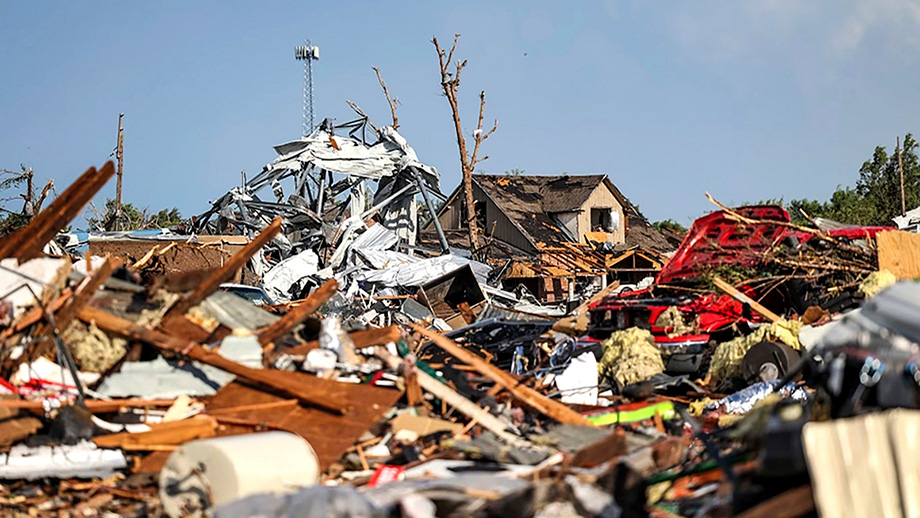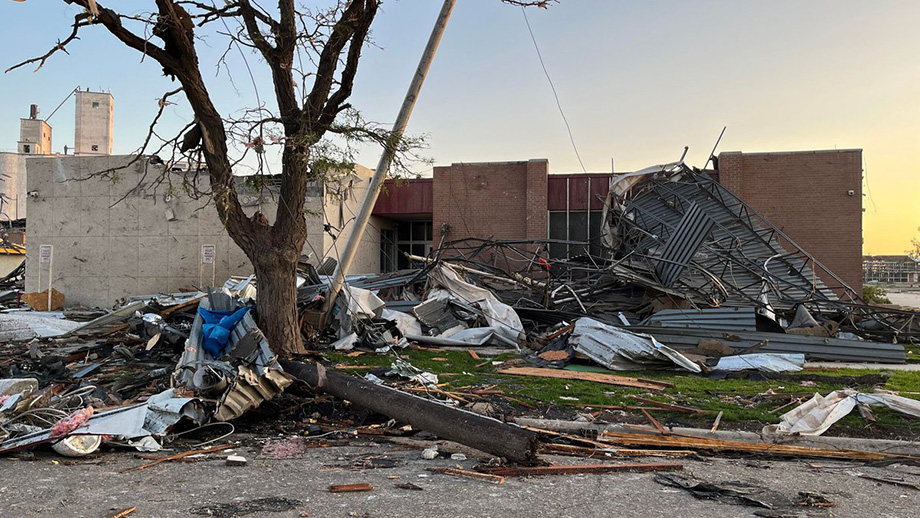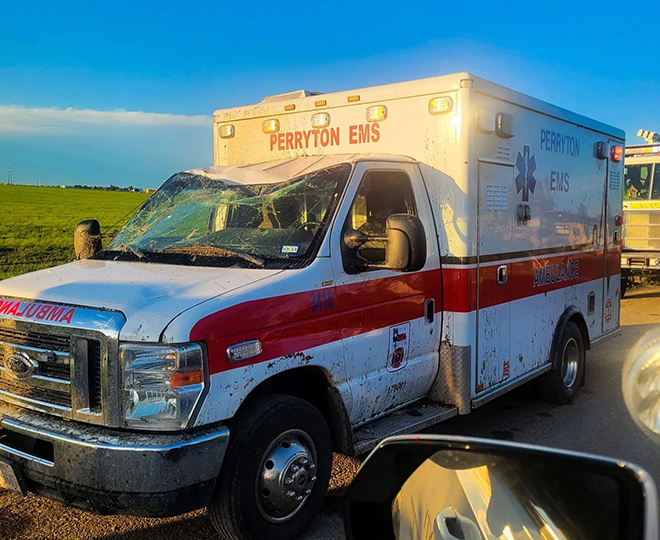MEMBER VOICES: Triage in the moment of trauma
Health care team springs to action when tornado rips through Panhandle town
By Blake DeWitt, MD
It was the end of another full and exhausting day in clinic in my hometown of Perryton. My three daughters were away at church camp with my fiancée, so I was looking forward to a nice quiet evening. As I drove home, I noticed the storm that was building.
One of my favorite things about living in the Texas Panhandle is watching a storm build and roll in over the plains. The beauty of such a thing is hard to overstate. So, I found myself doing just that, watching the storm build as I drove.
Once I arrived at home, I positioned myself in the recliner to finish up a few notes from work. Then the lights began to flicker and finally went out completely. Wind in the Panhandle is nearly as common as the saying “y’all,” so having the lights shut off as a storm rolls in is nothing out of the ordinary. In fact, I found it a good excuse to take a nap.
I moved to the couch but as soon as I laid my head down, I received a phone call from our hospital CEO, Kelly Judice: “I need you at the hospital now.” Small towns in Texas still carry a sense of community and when people call saying they need help, it’s understood you go. You don’t question; you simply go. I loaded up into the truck and headed to the hospital.
As I drove up to the hospital, I noticed numerous private vehicles in the parking lot, but no EMS. I walked through the ER doors and saw a mass of injured people. Unbeknownst to me, an EF3 tornado had torn through our small town starting on the north side, striking a trailer park, moving down Main Street, then finally exiting on the east side of town through yet another trailer park. It had hit the most vulnerable areas of Perryton, and the toll was just beginning to show. No sirens sounded and no warning was given.

Once inside the ER, I approached the on-call physician, Dr. Childers, who was methodically triaging patients. Already, there were at least 20 patients sitting in our ER that has a capacity of six beds. The hall next to the ER was lined with patients down both sides, and more continued to stream in through the front doors.
I asked where I could be of assistance but before I finished, two nurses grabbed my arms, each pulling me in different directions. One nurse had a child with a laceration to the eye. He was sobbing in the arms of his father, who was also injured. The second nurse was pulling me toward a lady who was moaning in pain but was otherwise minimally responsive. I moved to help the lady and quickly established an effective airway.
As physicians at Ochiltree General Hospital, we are required to maintain our Advanced Trauma Life Support training. On that night, my ATLS training would be put to the test.
Not a single person that came into the ER that night lost their life. It was nothing short of a miracle.
I began to perform primary surveys of each patient that I came upon to address any needs seen through the ABCD method – airway, breathing, circulation, and disability. Following this examination, I would ask the nurse with the patient to get any medications needed for pain relief or to further stabilize them, write a few quick notes on the triage card, assign a nurse to stay with the patient to monitor for changes, and move to the next patient.
Despite our efforts, we quickly ran into complications with our limited resources. First, we ran out of triage cards. The hospital had stored two 50-count packages of triage cards to be sure we had plenty for a mass casualty event. Up to this point the most that had ever been seen on a mass casualty at this hospital was 12 patients, so having 100 triage cards seemed a bit like overkill. As we found out, it was not nearly enough.
Having to think on our feet, we began taping paper towels to patients’ chests and writing their triage level, suspected injuries, and medications given. This type of adaptability became key for us as we worked through the evening.
The next complication was noticed by our pharmacist who saw a lag in getting medications out of the automated dispenser, as our computer system was down. She remedied the situation by setting up an impromptu pharmacy outside the ER, and with a pen and paper, she wrote what medication was prescribed, the amount given, and to whom it was being administered.
All the hospital employees jumped in to help in similar fashion without question. When we ran out of nurses to stay by a patient’s side to monitor them, receptionists, physical therapists, and board members stepped in. The dedication among the Ochiltree General Hospital staff that night was unwavering.
This was no more exemplified than by an LVN nurse whose mother’s home was hit by the tornado. After ensuring his family was safe, he reported to the hospital to help give care. It was only after about 30 minutes that someone noticed this particular LVN had arrived in a T-shirt and boxer shorts. He was politely asked to take a moment to put some scrubs on before continuing to care for patients.
Despite such dedication, patients continued to amass. Soon there was a line of patients awaiting CT scans 14 gurneys long. Transportation could not come soon enough, but we still had not seen a single EMS ambulance. We then discovered the reason: the EMS station had been demolished by the tornado.

It turned out that as soon as they could, folks began to dig out the ambulances with front-end loaders. Several paramedics would later arrive at the hospital in an ambulance with a partially crushed cab and a windshield that had been kicked out so they could see to drive.
In the meantime, we still had critical patients that needed transfer to a larger facility. Our administration helped to organize this by calling the RAC (Regional Advisory Council) and we quickly had seven EMS units from three different states arrive to help transfer patients. We began quickly stabilizing patients and shipping them to larger facilities.
Our employees began functioning together like a well-tuned orchestra, each dividing up and finding areas to help. Other doctors, both from our town and a nearby community, arrived and quickly got to work caring for patients. Dr. Childers and I managed immediate needs in the ER. Dr. Blasingame, our general surgeon, assisted with placing chest tubes and performing other procedures. Dr. McGaughy helped to establish an area for our nurse practitioners to address patients with lacerations, using their phone flashlights and what little light came through the windows to see by, since the power had been knocked out in the adjoining clinic. Dr. Seiwert saw to the urgent needs of patients in the ICU area. Dr. O’Beirne addressed patient care while simultaneously helping to get transfers set up for patients. Some of the patients left through the regular ambulance bay while others left through the north door of the hospital, all being orchestrated by Dr. O’Beirne.
Before we knew it, all the patients were gone except for one that we found hiding around a corner in the hallway, and another lady who had made her way down to a hospital room. She said she knew we were busy and was happy to wait her turn.

In the first 24 hours following the tornado, 160 patients would travel through the doors of the Ochiltree General Hospital ER. One hundred and six of those patients would be seen in the first four hours. There were 40 transfers, six critical patients, and six severe patients, but not a single person that came into the ER that night lost their life. It was nothing short of a miracle.
Nearly one year before the fateful evening, Ochiltree General Hospital had shirts made with the Bible verse, Esther 4:14: “You were born for such a time as this.” I have given much thought to this verse since that day. It seems in every medical student’s application, when asked why you wish to become a doctor, each of us answers with some form of “to help others.” Along the way, those dreams often become difficult to achieve among the mounting pressures to perform, frustrations with getting patients access to medicine, and the constant demands on our time.
But for me in the midst of a tragedy, I was given the ability to see my purpose. I am thankful that God allowed me to be a part of such an exceptional team that could rally together to help our community in their time of need.
Today, as you drive down Main Street in Perryton, you still see the scars from that evening. It will likely take months or even years for our community to recover. Some members of our community have lost too much and decided to make a new life somewhere different. Despite the odds though, our community continues to rally to meet the challenge.
We have a motto in Perryton that I believe sums up our philosophy: “Ranger pride never dies.” That pride in our community bonds us together and allows us to continue to move forward.
Blake DeWitt is a Family Physician who was born and raised in Perryton, Texas. After residency and fellowship, he returned home to set up DeWitt Family Practice, where he maintains the tradition of rural full-spectrum family medicine, including inpatient care, ER work, clinic, and obstetrics. He is married to Katy Beth DeWitt and has three daughters: Kallie, Chloe, and Emma. He enjoys spending time with his family as well as hunting and fitness.
